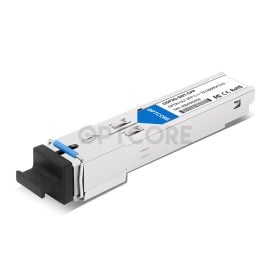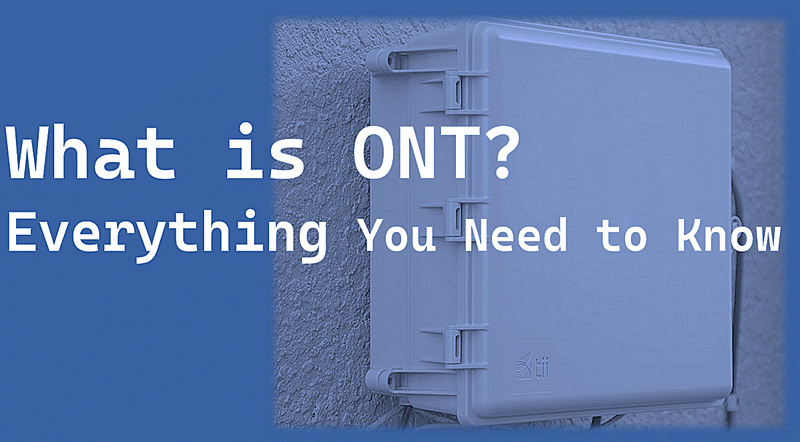Blog, Network Cabling, Networking Device, Optical Networking
What is ONT? Everything You Need to Know
According to a market research study, FTTx will serve nearly 60% of the world’s broadband subscribers by the end of 2025. The increase in fiber optic subscribers cannot be achieved without using fiber optic Internet. One of the components of fiber optic Internet operation is the optical network terminal (ONT). So, what is ONT?
Many of you may not know much about this behind-the-scenes hero. In this blog, we’ll explain what an ONT is, why it’s crucial in building a fiber-optic Internet, how it differs from other network devices, and other information you may care about.
Table of contents
What is ONT?
“ONT” stands for Optical Network Terminal. It is sometimes referred to as an “ONT box,” “fiber box,” or CPE (Client Premises Equipment) and is the interface between the Internet Service Provider (ISP) and the fiber optic Internet end user.
This device is critical in a Fiber-to-the-Premises (FTTP) or Fiber-to-the-Home (FTTH) setup because it converts the optical signals sent over the fiber optic cable into electrical signals that can be understood and used by devices such as your computer, laptop, or cell phone.
It is usually a small white or black plastic box mounted in the basement, on an outside wall, in a closet, or somewhere out of view that doesn’t take up much space.
How Does an ONT Work?
When your computer is connected to the Internet, the modem in your home provides a connection to an Internet service provider. Your computer uses this connection to send information to the ISP, and then the modem sends the request to ONT.
When it receives the request, ONT takes the information from the modem and acts as a “translator,” converting it into an optical signal. It then sends the signals over the fiber optic cable to the central office, which splits them into individual lines through a splitter box and sends them to different destination customers.
Once all the lines are sent to their destinations, they are combined again by another splitter box and returned to the central office. The optical signals from the fiber optic cable are then converted back into electrical signals. And sent to the modem.
Components of an ONT Device
Although ONT may look like a box on the outside, it’s a lot of things on the inside. Here are the typical components inside :
- Fiber Optic Input: This is where your Internet Service Provider’s fiber optic cable connects to the ONT.
- Optical Converter: This is the heart of the ONT. Converts incoming light pulses into electrical signals.
- Ethernet Ports: These allow you to connect your router or device directly to the ONT for Internet access.
- Phone Ports: These ports allow you to connect a cell phone if you have landline service through a fiber optic provider.
- Coaxial Ports: Some ONTs use these for TV service, although many modern fiber optic setups use IPTV.
- Power Supply: This keeps all the crucial components of the ONT powered up and running smoothly.
- Status Indicators: These LEDs show your connection’s status and help troubleshoot.
ONT vs. Ethernet Cables: Key Differences Between Them

ONT is a device in its own right and has no unique cable type. So, when it comes to ONT cables, they are fiber optic cables that ONT connects to the network. So, the difference between an ONT cable and an Ethernet cable is the difference between a fiber optic cable box and an Ethernet cable.
The difference between fiber optic cable and Ethernet cable:
- Construction: glass or plastic fiber bundles compose fiber optic cables inside, and Ethernet cables are composed of multiple pairs of twisted copper wires inside. Fiber optic cable box Ethernet cables have multiple layers of protective material on the outside.
- Transmission of data form: fiber optic cable in the form of optical signals to transmit data, Ethernet cable in the form of electrical signals to transmit data.
- Transmission distance: Fiber optic cable attenuation is small, allowing data to be transmitted over longer distances. Ethernet cable has higher attenuation, especially when the data rate is high and the data transmission distance is shorter.
- Application Scenarios: Fiber optic cables are typically used when high-speed, long-distance data transmission is critical. Ethernet cables are widely used for local area networks (LANs) in offices, homes, and small businesses.
ONT vs. Modem: What Are The Key Differences?
- Compatibility: Designed for fiber optics, ONT converts optical signals into electrical signals. Modems designed for DSL and cable Internet can handle electrical signals.
- Performance and Speed: The performance and speed of an ONT is superior to that of a modem.
Why Are ONTs Important?
The ONT plays a crucial role in a fiber network’s overall performance and efficiency. Here’s why it’s important:
#1. High-speed Internet
ONT’s advanced technology efficiently converts optical signals into electrical signals and keeps transmission speeds high. This allows users to experience excellent home internet speeds, such as smoother movie-watching, faster downloads, and lag-free gaming.
#2. Reliable connection
Fiber-optic Internet is inherently more reliable than traditional copper-based Internet because fiber-optic cables are unaffected by electromagnetic interference. Ont maintains this reliability by providing a stable, consistent connection.
#3. Future-proof
When your service provider upgrades, updating your firmware or replacing it with a newer model without significant changes to your home’s infrastructure is often possible.
#4. Service Integration
Most ONTs can handle multiple services from a single device, simplifying your home network setup. This saves space and makes it easy to manage your home network.
#5. More Secure
When you connect to the Internet using Wi-Fi, it’s easy for hackers to intercept wireless signals in the sky. You can protect yourself from these attacks by installing ONT because your data travels longer. Hackers cannot reach your system if they do not hack your ONT.
Types of ONT devices
There are various types of ONT devices for different needs and application scenarios. The following are common types you may encounter:
#1. Residential ONT
It is designed for home use and connects routers, phones, and TVs. This type is more powerful and easy to install, with sufficient interfaces to better meet home Internet needs.
#2. Commercial ONT
it is designed for office buildings and industrial spaces and is more powerful than home ONTs. They support higher data loads and more connections and often include enhanced Quality of Service (QoS), advanced security features, multi-user support, and enterprise network system integration.
-
 GPON OLT SFP Class C++ 1490nm-TX/1310nm-RX 20km TransceiverUS$ 59.00 (Excl. VAT)
GPON OLT SFP Class C++ 1490nm-TX/1310nm-RX 20km TransceiverUS$ 59.00 (Excl. VAT) -
 GPON ONT ONU SFF Class B+ 1310nm-TX/1490nm-RX 20km TransceiverUS$ 35.00 (Excl. VAT)
GPON ONT ONU SFF Class B+ 1310nm-TX/1490nm-RX 20km TransceiverUS$ 35.00 (Excl. VAT)
How Do You Install an ONT?

Your Internet Service Provider (ISP) will send an experienced technician to install the device for you, which will probably take a few hours, so you don’t have to worry about installation, but you can get an idea of what the installation process usually involves:
- Site Survey: The technician will evaluate the best location for your ONT, usually near a power source and where you most frequently use the Internet.
- Cable Installation: If not already present, fiber optic cable will be laid from the nearest access point to your home.
- ONT Installation: The technology will securely install your ONT in the selected location.
- Connections: they connect the fiber optic cable to the ONT and set up other connections (Ethernet, telephone, etc.) as needed.
- Power Up: The ONT is powered up and initialized.
- Configuration: the technology will configure the ONT to work with your service provider’s network and your home setup.
- Testing: Finally, they will run a test to make sure everything is working correctly and at the speed you paid for.
How do I troubleshoot when my ONT goes out?
Usually, ONT is reliable, but strikes are possible. Here are some common problems and quick fixes:
#1. No connection
First, check to see if the ONT connects to a power source (pay attention to whether there is an area power outage or a damaged battery backup) or if its switch is on (if there is an ON/OFF) and all cables are securely connected. The ONT’s power indicator should be green.
If everything is normal, try rebooting it and the router. Finally, you can contact your ISP for help if it is unresolved.
#2. Slow Internet Speed
First, run a speed test to confirm the problem, see if other devices on your network use a lot of bandwidth, and try turning off background downloads or synchronization.
If the problem persists, contact your service provider for advice on whether the network is down in your area; if the local network is working properly, they will diagnose and maintain it remotely for you.
FAQ
Q. What does ONT stand for?
A. ONT stands for Optical Network Terminal, a device that converts fiber optic signals into digital signals that your equipment can understand.
Q. Which is better for long-distance connections: ONT or Ethernet cable?
A. For long-distance connections, ONT cables are the better choice. Fiber optic technology significantly reduces their signal attenuation over long distances, making them ideal for maintaining signal quality over long distances.
Q. Can ONT be used with a router?
A. ONT is an Internet channel for fiber-optic Internet, just as modems are used for coaxial cable Internet connections. However, keep in mind that it is dedicated to fiber-optic Internet only. You cannot use it with coaxial cable Ethernet, such as a cable modem or router!
Q. Is an optical network terminal a router?
A. No, the Optical Network Terminal is not a router. It interfaces between a fiber optic network and a business or home local area network (LAN). In contrast, a router manages traffic within a LAN, assigns IP addresses, and provides wired or Wi-Fi connectivity. However, some ONTs have integrated routers and Wi-Fi, so you don’t always need a separate router to connect your devices.
Q. Does ONT offer Wi-Fi connectivity?
A. While the primary function of the ONT itself is to convert optical signals to electrical signals, some ONTs integrate router functionality, including Wi-Fi, to provide direct wireless connectivity.
Q. Can I install an ONT myself?
A. Due to the technical nature of fiber optic technology and network configuration, installing an ONT usually requires professional handling by a service provider.
Conclusion
ONT is a device that converts optical signals into electrical signals to ensure a high-speed, reliable, future-proof network service experience. As fiber optic networks continue to grow in popularity, optical network terminals (ONTs) are becoming a key hub for connecting fiber optic networks to subscriber devices.
This article mainly introduces ONT and its working principles, the difference between Optical Network Terminals and other equipment technologies, the installation process, and troubleshooting. We hope this article helps you understand ONT better. If there is any error, you can contact us.
read more
- ONU vs. ONT vs. SFU vs. HGU: What is the Difference?
- GPON vs EPON, what is the difference?
- Overview of GEPON Technology
- Passive Optical Network (PON) Knowledge Introduction
Reference







